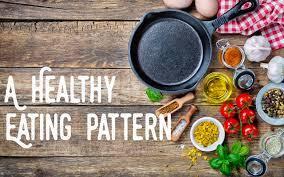Concentrate on healthy eating patterns, rather than restrictive diets!

Eating healthy shouldn’t be hard, confusing or limiting. So, what's the best way to do it? Some of today's popular diets say to cut out certain foods and with so many diet books and bloggers, it can be easy to become confused. But no matter what fad diet prevails at the moment, vegetables, fruits, whole grains, healthy fats and lean protein foods will always prevail.
A Healthy Eating Pattern
Rather than eating an exclusively low-fat or low-sugar diet, focus on your overall eating pattern. One meal does not make or break one's health; rather, it's what people do most of the time that has a significant impact. Increase vegetables in your meals along with fruits, whole grains, beans, seafood and lean meats and nuts. Try to eat less processed meats, sweetened drinks, desserts and refined grains.
Vegetables should take up the most space when filling your plate (roughly half). Fill the remainder with whole grains and lean protein foods. While not every plate requires each food group, pairing at least two or three different foods will increase your satisfaction and deliver more nutrients. And don't forget to pay attention to your body's hunger and fullness signals. Remember that eating mindfully is very important!
The Fat Food Group
The 2020-2025 Dietary Guidelines for Americans emphasizes oils rich in monounsaturated and polyunsaturated fatty acids as part of a healthy eating pattern, and recommends limiting saturated and trans fats. Choosing the right kinds of fats, including those from fatty fish such as salmon, vegetable oils, nuts and seeds is especially important.
Here are some tips that will help you make good decisions about Fat
- Instead of fried or breaded, try grilled, steamed or baked salmon, trout or mackerel.
- Vary your protein sources by eating more legumes (such as soy foods, beans and lentils).
- Choose lean cuts of meat and remove visible fat. Remove skin and fat from poultry.
- Choose low-fat dairy products or calcium-fortified plant-based alternatives.
- Top salads with nuts, seeds or garbanzo beans instead of croutons. Use oil-based salad dressings instead of cream-based dressings.
Sugar Tips
The 2020-2025 Dietary Guidelines for Americans recommend limiting added sugars to less than 10% of daily calories. Added sugars can be found in foods such as sugar-sweetened beverages and refined grain snacks and desserts. Naturally occurring sugars in foods such as fruit and milk are not added sugars.
How to reduce Added Sugar:
- You can enjoy sugary desserts in moderation, just avoid doing it often!
- Instead of a post-dinner dessert, close out mealtime with some fresh fruit or herbal tea (enjoy it without added sweeteners).
- Switch from sweetened yogurt with added fruit to plain low-fat yogurt or plain plant-based yogurts. Then, add fresh fruit for a nutritious, naturally sweet mid-morning snack.
If you need help developing a personalized healthy eating pattern that includes appropriate amounts of healthy fats and sugars, contact a registered dietitian nutritionist.
